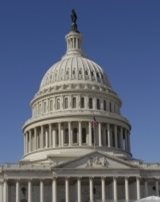
ASTMH continues to work with its partner organizations to make its views known to Congress, the Administration and the Biden-Harris transition team. Letters that ASTMH led or joined include:
- IDSA-led letters to President-elect Biden and the House and Senate co-sponsors of the PASTEUR Act urging them to create a national, One Health plan to tackle AMR.
Read More
Democrats Win Unified Control by Slimmest of Margins
What Happens Post-January 20?
Congress Passes COVID-19 Relief and Fiscal Year 2021 Spending Package
By the Numbers: New Funding for Global Health, COVID-19 Response
Trump Administration May Freeze Some Foreign Aid
WHO Grants Emergency Vaccine Authorization
COVAX Facility Increases Vaccine Commitments
Democrats Win Unified Control by Slimmest of Margins
With their two wins in the Georgia Senate runoff elections on January 5, Democrats will have control of the Senate once the winners, Raphael Warnock and Jon Ossoff, are sworn in (Georgia’s certification deadline is January 22). Vice President-elect Kamala Harris will break the 50-50 tie between the parties. Combined with their narrow majority in the House and Joe Biden’s presidency, Democrats will have unified control of the legislative and executive branches.
What Happens Post-January 20?
While the Georgia election ensured that President-elect Biden will have control of the Senate, he will have many challenges. This will make it easier for Senate confirmation of Biden Cabinet nominations and other appointees. The Senate majority and minority leaders will have to work together to determine how they will govern under a 50/50 Senate. Any type of sweeping change will take either all the Democrats or a majority of Democrats and some Republicans to agree. This won’t be easy. Moderates of both parties, already an endangered species, will be sought by both sides to support their positions. A new COVD-19 relief package becomes far more likely and will face an unknown level of challenge due to concerns about the staggering debt that the U.S. has incurred.
Congress Passes COVID-19 Relief and Fiscal Year 2021 Spending Package
Congress, by wide margins in both houses, finally passed a bill that combined new COVID-19 relief funding with FY2021 appropriations on December 21. After initially refusing to sign the $2.3 trillion package into law, President Trump relented on December 27. Congress reached a deal after breaking impasses over stimulus checks, Federal Reserve authorities and unemployment benefits, while dropping business liability protections and state and local aid altogether.
By the Numbers: New Funding for Global Health, COVID-19 Response
The year-end funding package contains the following amounts for key global health and COVID-19 programs (numbers not necessarily exhaustive):
FY2021 Appropriations
- NIH - $42.9 billion, an increase of $1.25 billion over the enacted FY2020 level, including
- $3.09 billion for HIV/AIDS Research
- $220 million for universal flu vaccine research
- $10 million for tick-borne disease research
- CDC - $7.9 billion, an increase of $125 million over FY2020 enacted, including
- $695 million for public health emergency cooperative agreements with state and local health departments
- $361 million to strengthen lab capacity, including $50 million for public health data modernization
- $193 million for global disease detection
- Public Health and Social Services Emergency Fund (PHSSEF) - $2.8 billion, $110 million over FY2020 enacted, including -
- $770 million for Project BioShield
- $705 million for the Strategic National Stockpile
- $597 million for BARDA
- $287 million for pandemic flu preparedness
- USAID - $1.71 billion, $48 million over the FY2020 enacted level
- State Department -
- $9.2 billion for Global Health, up $103.5 million from FY2020
- $5.9 billion for PEPFAR, the same as FY2020, of which $1.56 billion is for the Global Fund
- The bill also reiterates the 33% U.S. share commitment to the Global Fund
- $4 billion for GAVI, as a contribution, along with $290 million in annual appropriations
- $855.5 million for Maternal and Child Health, up $4.5 million
- $319 million for tuberculosis, up $9 million
- $190 million for global health security, up $90 million
- $100.7 million for combatting wildlife trafficking
COVID-19 Relief
- CDC - $8.75 billion for vaccine distribution and administration, of which
- $4.5 billion is for state, local, territorial and tribal public health departments
- ASPR - Assistant Secretary for Preparedness and Response, $22.945 billion, including
- $19.695 billion for BARDA for vaccine manufacturing and procurement
- $3.25 billion for the Strategic National Stockpile
- PHHSEF - Public Health and Social Services Emergency Fund, $25.4 billion, including
- $22.4 billion for testing and contact tracing
- $3 billion to reimburse hospitals and healthcare providers
Trump Administration May Freeze Some Foreign Aid
The Trump Administration, in one of its final moves, may request that Congress rescind some foreign aid spending. President Trump indicated he would do so in a signing statement appended to the year-end spending agreement when he signed it into law. As a result, the funding would be frozen for 45 days, although the funding would automatically resume if Congress does not act. Nevertheless, the freeze would spill over into the Biden Administration. At the time of this writing it is still unclear exactly which spending may be frozen.
WHO Grants Emergency Vaccine Authorization
The WHO issued its own emergency approval of Pfizer/BioNTech’s COVID-19 vaccine, clearing the way for the vaccine’s distribution by international health bodies like UNICEF and PAHO.
COVAX Facility Increases Vaccine Commitments
The international COVAX facility, meant to ensure equitable COVID-19 vaccine distribution, announced in late December that it now has agreements in place for almost 2 billion COVID-19 vaccine doses. The total includes a number of different vaccines, some that already have received emergency approval and some still in late-stage trials. COVAX includes 190 “participating economies.”